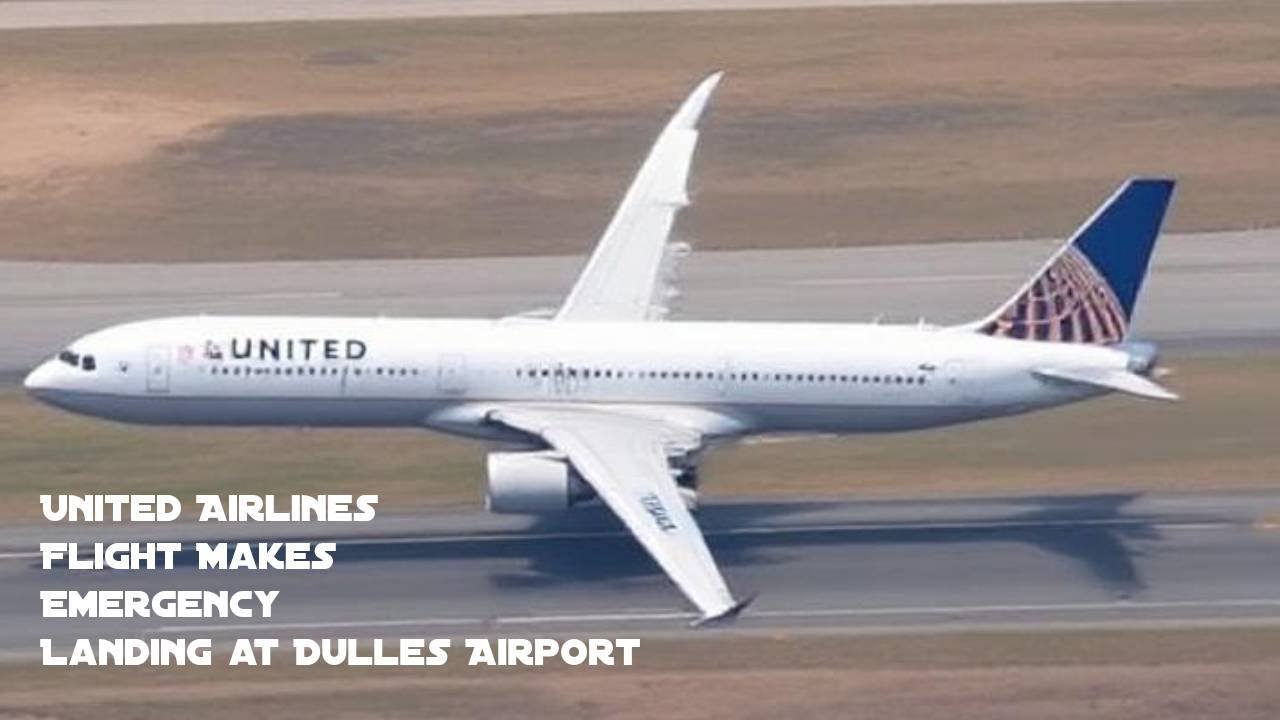When you board a flight, the last thing you expect is an emergency. But that’s exactly what happened when a United Airlines Flight Makes Emergency Landing at Dulles Airport, sending shockwaves through passengers and aviation circles alike.
Mid-flight disruptions are more than just headlines—they’re moments of real concern for those onboard and their families. Confusion, fear, and questions quickly follow. Was anyone hurt? What caused the emergency? Is flying still safe?
In this post, we break down everything we know about the United Airlines Flight Makes Emergency Landing at Dulles Airport incident. From the timeline and likely causes to expert opinions and airline response, we’ve gathered the most reliable details for you—all in one place. Whether you’re a concerned traveler or simply staying informed, this article gives you clarity, fast.
Incident Overview: What Happened on the United Flight?
A routine flight turned into a high-stakes situation when a United Airlines Flight Makes Emergency Landing at Dulles Airport. The flight, which had been cruising without issue, suddenly encountered an unexpected technical irregularity mid-air. According to preliminary reports, the pilots identified the issue quickly and made the decision to divert for the safety of all onboard.
The aircraft was not far from its destination, making Dulles the best option for a safe and immediate landing. Passengers described a calm but serious atmosphere as the crew initiated emergency procedures. The flight attendants provided clear instructions, and the pilot made an announcement reassuring passengers of their control over the situation.
Fortunately, no injuries were reported. The plane landed safely, and emergency crews were waiting on the tarmac, ready to assist if needed. Though further details are still under review, initial accounts suggest the crew handled the incident with professionalism and precision.
In the next section, we’ll walk through how the ground response at Dulles unfolded in real time—from the emergency alert to post-landing coordination.
Immediate Response at Dulles Airport
Once the United Airlines Flight Makes Emergency Landing at Dulles Airport, airport personnel acted swiftly to ensure a safe and efficient response. As soon as the flight declared an emergency, air traffic controllers at Dulles prioritized the incoming aircraft, clearing surrounding airspace and coordinating with fire and rescue units on the ground.
By the time the wheels touched down, a full emergency team was already positioned near the runway. This included fire trucks, paramedics, security staff, and airport operations teams—all trained for these exact situations. Their mission: secure the aircraft, assess any injuries, and begin post-landing procedures without delay.
Passengers remained onboard briefly while safety checks were performed. Then, under the guidance of the cabin crew and ground personnel, deplaning began smoothly. Buses transported passengers to the terminal, where additional United Airlines staff offered updates and accommodations.
Dulles Airport’s response highlights how well-rehearsed emergency protocols can minimize chaos and maintain safety. Everyone—from air traffic control to first responders—played a critical role in managing the situation professionally.
Next, let’s explore how passengers experienced the event and what conditions were like inside the cabin during the emergency landing.
Passenger Safety and Onboard Conditions
For the passengers on board when the United Airlines Flight Makes Emergency Landing at Dulles Airport, the experience was both alarming and reassuring. While the unexpected descent created understandable anxiety, the flight crew’s calm demeanor helped maintain order in the cabin.
Eyewitnesses report that the cabin remained quiet, with passengers fastening their seatbelts and listening closely to instructions. The flight attendants remained composed, moving quickly to secure the cabin and ensure passengers were informed and calm. Some passengers noticed a slight cabin pressure fluctuation or mechanical noise, while others simply felt the plane descending faster than usual.
Medical staff met the aircraft on arrival, but no serious injuries were reported. United Airlines made arrangements for passengers to receive food, updates, and assistance with rebooking if needed. Children, elderly passengers, and those with special needs were given priority care.
In stressful situations like these, the onboard atmosphere can either escalate panic or preserve safety. In this case, coordinated action by both flight and cabin crews ensured that everyone remained protected and informed.
Up next, we’ll review the official statement released by United Airlines following the emergency landing and how it addressed public concern.
Official Statement from United Airlines
Shortly after the United Airlines Flight Makes Emergency Landing at Dulles Airport, the airline released an official statement to the public. In it, United confirmed the safe landing, thanked the crew and emergency responders, and emphasized its commitment to passenger safety.
The airline acknowledged that the emergency was due to a technical issue, though they did not specify the exact cause pending further investigation. What stood out in the statement was United’s transparency. They assured travelers that safety protocols were followed precisely and praised the flight crew for their professionalism.
The statement also included details on how affected passengers were being supported—through rebooking, transportation, meals, and hotel accommodations if necessary. United emphasized that all passengers were safe and accounted for, with no reported injuries.
By promptly releasing a detailed yet calming message, United helped reduce speculation and build trust. Clear, timely communication like this plays a critical role in maintaining customer confidence, especially in crisis situations.
In the next section, we’ll look at how aviation authorities, including the FAA, are following up with an official investigation into the incident.
Investigation and Regulatory Follow-Up
Whenever a United Airlines Flight Makes Emergency Landing at Dulles Airport or any major U.S. airport, it triggers an official review by aviation authorities. In this case, the Federal Aviation Administration (FAA) and possibly the National Transportation Safety Board (NTSB) will lead the investigation to determine what went wrong—and whether preventive action is needed.
Their work typically begins by securing flight data, reviewing the black box, interviewing crew members, and inspecting the aircraft. Maintenance logs and pilot reports are key to identifying whether the issue was mechanical, procedural, or environmental.
Although the incident was managed without injury, regulatory agencies still treat it with high importance. They’ll want to know if standard protocols were followed, if the aircraft had any prior reported issues, and whether safety improvements could be made.
Depending on the outcome, the FAA might issue safety advisories, request modifications, or even recommend training updates across the airline industry. These steps are essential to maintaining the strong safety record of U.S. commercial aviation.
Next, let’s take a closer look at the specific aircraft involved in this incident and its operational history leading up to the event.
Aircraft Details and Flight History
Understanding the aircraft’s background helps shed light on why the United Airlines Flight Makes Emergency Landing at Dulles Airport. Reports confirm the plane was a Boeing 737, one of the most commonly used models in United’s domestic fleet. This specific aircraft had been in service for several years and had undergone routine maintenance checks as per federal guidelines.
According to flight tracking data, the jet departed on schedule and followed its expected route until a mid-air technical alert prompted the emergency diversion. Flight data records show a controlled descent pattern, suggesting the issue, while serious, did not compromise the pilots’ ability to safely land the aircraft.
The aircraft’s past flight history includes hundreds of successful trips, and there were no public safety warnings or mechanical incidents previously associated with it. However, post-incident inspections will determine whether a specific component failure or system error occurred this time.
Airlines maintain extensive logs for every plane, and these records will now play a central role in the FAA’s investigation. The outcome may influence future maintenance protocols or component upgrades.
Now, let’s explore how this incident compares with past emergency landings at Dulles Airport.
Similar Past Incidents at Dulles Airport
The fact that a United Airlines Flight Makes Emergency Landing at Dulles Airport may sound alarming, but this isn’t the first time such an event has occurred. Like all major international airports, Dulles handles emergency landings occasionally—each with different causes and outcomes.
Past incidents at Dulles have ranged from smoke in the cabin and engine issues to bird strikes and medical emergencies. In most cases, these landings ended without injury, thanks to the coordination between pilots, air traffic control, and emergency teams on the ground.
For instance, in 2022, another commercial flight diverted to Dulles due to a cracked windshield. That incident, like this one, resulted in a safe landing and immediate investigation. These patterns reveal a consistent ability by airport teams to handle emergencies quickly and professionally.
Dulles has the infrastructure, runway capacity, and trained personnel to support such operations at a moment’s notice. While each situation is unique, the outcomes tend to be the same: fast response and safe recovery.
In the next section, we’ll take a look at how the public reacted on social media—and what sentiments were shared in the hours after the landing.
Social Media Reactions and Public Sentiment
News spreads fast in the digital age—especially when a United Airlines Flight Makes Emergency Landing at Dulles Airport. Within minutes of the landing, passengers and observers took to platforms like Twitter, Facebook, and Instagram to share their experiences and reactions.
Some passengers posted photos from inside the cabin, showing the moment after the emergency announcement. Others praised the crew’s professionalism, describing calm instructions and smooth handling throughout the ordeal. Hashtags like #UnitedAirlines and #DullesAirport trended locally, drawing public attention and news coverage.
Reactions from the general public were mixed. Many users expressed relief that everyone was safe. Frequent flyers commented on how this reaffirmed their trust in airline safety systems. A few expressed concern, asking if technical failures like this were becoming more frequent.
United’s quick and transparent communication also drew praise. Social media analysts noted that the airline’s official post—thanking the crew and assuring customer support—helped shape a positive narrative in a moment that could have turned negative.
Social platforms have become a real-time lens into public perception. In the next part of our article, we’ll answer some of the most frequently asked questions people have about emergency landings in the U.S.
Conclusion
The recent event where a United Airlines Flight Makes Emergency Landing at Dulles Airport serves as a powerful reminder of aviation’s built-in safeguards. From the pilots’ swift actions to the airport’s rapid emergency response, every system worked as intended.
While such incidents can raise concern, they also highlight how rare and well-managed emergency landings truly are. The crew stayed composed, the passengers remained safe, and the airline communicated promptly—turning a tense moment into a textbook example of aviation professionalism.
If you fly often or are planning your next trip, let this story reassure you: air travel remains one of the safest ways to get from point A to B. Still, staying informed makes us better prepared and more confident travelers.
Have questions or experiences to share? Let us know in the comments below. And if you’d like to stay updated on similar aviation news, subscribe to our newsletter.
Emergency landings are uncommon but not unheard of. With over 45,000 commercial flights daily in the U.S., only a small fraction involve emergencies. Most are precautionary and handled without injury.
Airlines follow strict safety protocols. Pilots are trained for various scenarios and work closely with air traffic control. Cabin crews secure passengers, and emergency teams are deployed on the ground before the aircraft lands.
Compensation depends on the cause. If the emergency was due to a mechanical issue or airline fault, passengers may be eligible for compensation or vouchers. Weather-related or safety-based diversions usually don’t qualify.
The Federal Aviation Administration (FAA) investigates every emergency landing. It reviews flight data, aircraft maintenance history, and crew actions to ensure aviation standards were followed and to prevent future risks.










